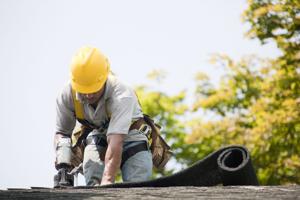Rosie on the House: What you need to know about your roof

Question: I am a first-time homeowner. Before I have a problem, what do I need to know about my roof?
Answer: First of all, congratulations on owning your first home. And second, good for you for being proactive.
Your roof is much more than a bunch of shingles and tiles. It is a complicated system that needs regular inspections and maintenance to protect you from the elements.
Jim McClain and Robyn Charland of Canyon State Roofing, a Rosie on the House certified partner, share some things homeowners should know about their roofs.
Roofers
Roofers supply, install, maintain and repair your roofing system. When you hire a roofing contractor (or any contractor for that matter), select a contractor licensed by the Arizona Registrar of Contractors. Do your homework. Read reviews and research the company. Better yet, talk to past clients.
People are also reading…
When it comes time for work to be performed, the contract needs to be scrutinized and include:
The scope of work section needs to include a detailed description of the work to be performed and the materials used. The roofing product and the underlayment manufacturers and their respective warranties need to be detailed in the contract.
Warranty details are important. Beyond the statutory requirement of two years for the roof, the materials have a warranty that extends well beyond that. Not all manufacturers are the same. If the material fails, some manufacturers will include labor for replacement (a huge benefit) as well as material replacement. Others include only material replacement, and some will prorate the wear on the material and only warranty to a certain level. The manufacturers and their warranties need to be spelled out specifically. The transferability of the warranty to someone who buys your home is another detail that needs to be included. Find out if this is expected or something the buyer needs to ask for. The detail of the work to be performed should include whether associated materials, such as flashings or roof pipe jacks, will be reused or new.
Ask the contractor about follow-up inspections and whether they are included in the contract.
Verify that the expiration dates of the policy are well beyond the date your project is due to be completed.
Check the experience level of the contractor. A skilled asphalt shingle installer may not have the skill set needed for a metal roof.
As always, be sure the contractor is licensed, bonded and insured. Check roc.az.gov and get a certificate from their bonding company and the insurance company. We can’t stress this point enough.
Roofing
New or replacement materials need to be chosen for their longevity and their aesthetics.
The applications. Certain applications can require specific materials to be used. Flat or low slope roofs require different materials than tile or metal roofs.
Products. The products used must be compatible with each other.
Underlayment. Most roofing systems begin with the underlayment. McClain is a big proponent of the updated asphalt-impregnated heavy-duty products. Usually, an underlayment of 40 to 50 pounds can be more effective than a synthetic underlayment. He notes the synthetic systems have been failing across the valley, particularly under tile roofs, due to the intense heat and sun of the desert.
Warranty. Again, have each product spelled out specifically, and ask about the warranty and compatibility.
Roofs
Once your roof has been installed and the written warranties are provided, your roof needs regular maintenance. There are maintenance programs for every type of roof. The goal is to discover issues that if left unchecked, can exacerbate the deterioration of your roofing system. Some of those include:
Blistering on flat roof surfaces. This is where the roofing material has separated from its substrate. That can be the underlayment of the roof structure itself. These can become breech points for water and critter infiltration and cause further damage if left unchecked.
Broken or missing tiles. While unsightly, a broken or missing tile can also lead to other damage. Because this is a collection point for debris and an infiltration point for moisture, issues like this need attention.
Missing asphalt shingles. Damage to this type of roofing system can be the result of wind, hail and a careless repair person on your roof. Missing asphalt shingles are an even greater threat to moisture infiltration.
Debris build-up on your roof prevents the gutters, scuppers or other drainage systems from doing their work.
Backed-up gutters can cause damage to the roof and cause leaks. Any roof inspection should include a good look at your guttering system.
A solid roofing contractor will typically offer a maintenance program designed for your roof as an addition to their roofing services. Having such a contract will spell out a standard interval of roof inspections (usually every two years), the items that will be inspected and the repair work to be performed. Depending on the extent of the repairs, a proposal will be presented to address the issue.
As with any aspect of your home, castle or cabin, starting with a sound contractor and good design, professional execution should be followed by paying attention to the maintenance of your home. This will help your home, and most importantly you, weather the storm.
Contrary to it’s name, not everything can be cleaned with an all-purpose cleaner.
An Arizona home building and remodeling industry expert for more than 40 years, Rosie Romero is the host of the syndicated Saturday morning Rosie on the House radio broadcast, heard locally from 10 to 11 a.m. on KNST-AM (790) in Tucson.
For all the latest Life Style News Click Here
For the latest news and updates, follow us on Google News.
